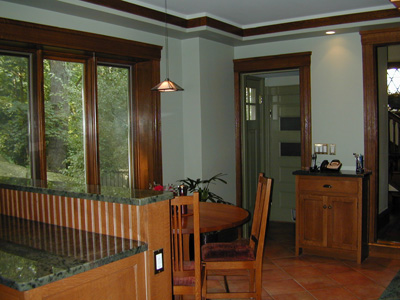It is 1975. I nose my car slowly into the mouth of a winding driveway in the mountains above Salt Lake City. My companion and I are in search of the only Frank Lloyd Wright building in the state of Utah, a hunting lodge built in the 1930’s for a U.S. Steel executive in the town of Bountiful.
Immediately, we encounter a printed “No Trespassing” sign; below it is a crude, hand-lettered addendum: "Survivors will be prosecuted." We are frightened, but being young and feckless, also thrilled. We continue. After twisting for almost a quarter mile uphill through a dense woods, we come into a clearing. There is the house, more of a cottage, really.
There is no other vehicle there. We emerge cautiously from our car and are beginning to circle the house, when we hear an engine. A pick-up truck pulls in behind us, blocking our car in. A burly young man steps out, visibly angry; there is a rifle in a rack silhouetted in the truck’s rear window.
“Can you read?” he asks. Scared, I throw out a flood of words: me and my girlfriend are architecture buffs on the way from Boston to the coast stopping wherever possible to see examples of FLLW’s work of which your house is a beautiful example and we’ll be happy to leave immediately sorry to disturb you&
Strangely, he softens, and within minutes he is showing us around the interior, telling us his sad story. He had bought the cottage, which was run down, to use as a base for hunting. He was handy, and immediately started to “fix it up.” In his case this involved, among other changes, “flocking” the ceilings, and re-doing the fireplace with a flagstone hearth. Word got out, apparently through the building supply house, and he was descended upon by a delegation of architectural students from the University of Utah, who told him bluntly that his attempts at “improvement” were doing irreparable harm to a work of art, and that he must cease these bogus improvements immediately, and instead should “restore” the cottage to its original condition. “One of them even called me a ‘barbarian,’ he said, utterly bewildered. “"I never heard of Frank Lloyd Wright; I was just trying to make it better. Now, I wish I had never seen this place."
Though I was also shocked by the flocking, I found myself feeling genuinely sorry for the owner. My parent’s had built a Frank Lloyd Wright house some years before. Because they loved Wright’s esthetic, the irony the Bountiful house revealed was masked. The truth is, although you may buy or build a Frank Lloyd Wright house, you never really own it; rather, you are its “curator,” which is very different, and you must therefore stifle any impulse to “improve” it. Indeed, in order to ensure that no subsequent owner could “improve” my parent’s house in the future, my siblings and I spent a considerable amount of time and money getting a “conservation easement” on the house and grounds, which lowered the value of the property by legally specifying that no changes to the interior or exterior of the house or grounds could be made without the approval of the Frank Lloyd Wright Building Conservancy, backed by the Sate of Maryland. That done, my sister and I sold the house to my brother Tom with pleasure. I loved it too, but had no wish to become its curator, or the curator of anything else from the past, however innovative and lovely it might be. I liked to tinker, to change things. My brother did not, which made him an ideal steward.

FLLW’s Lewellyn Wright House, courtesy of University of Wisconsin Engineering Dept.
But this memory makes me think about how strange the whole business of architectural preservation and “improvement” really is. Especially in the case of Wright, who constantly revised and changed his own elaborate residences, and fought bitterly with those trying to conserve the ways of the past.
Despite a design career that lasted for sixty years, Wright spent little time or effort to preserve his own work. When asked what his favorite of his buildings was, he always replied “my next.” And he called his architecture “organic,” by which he meant “living,” and implicitly, therefore, destined to die.
There is in fact a school thought that argues that the “transitoriness” of the building is intrinsic to the intent of the builder and must be honored even if it ends ultimately in the complete decay of the structure. This notion starts in the eighteenth century with the fetishizing of “ruins’ as sublime examples of beauty, and continued in the nineteenth century with Ruskin’s hymn to architectural “weathering” as Nature’s finishing touch to any architectural structure.
This brings us up short, and reminds us of how distinctive architectural art is. No one, after all, wants to look at a “weathered” film, or listen to a “weathered” symphony, or look at a “weathered” painting.
And yet “weathering” has its limits in architecture. Yes, it should inspire us, but it needs to keep the rain out, too. Wright’s houses did not always do that. Many of his roofs leaked from the beginning, in some cases because his ideas were ahead of existing technologies. He even joked about it. One client is said to have telephoned him, distraught over a leak in her ceiling allowing water to drip onto the hors d’oevres at her house-warming party. “What should I do”, she wailed. “Madam, your house is a work of art and should not be left out in the rain,” he replied.
By the time he died, at age ninety-two in 1959, most of the art world agreed. His work was generally acknowledged to be of great importance in the history of art and therefore worthy of preservation.
But how do you preserve “organic” architecture? The same way you preserve anything else: by trying to arrest natural processes. Think of time as a river, and the built environment as all the material in its channel. As time goes by, the rocks in its bed are tumbled, smoothed, thrown up on its banks, which change constantly. But eventually, the rocks will become sand, will become something entirely other.
But in many human societies, ours among them, certain features of the stream bed are felt to be too important to be allowed to decay. So we strive to armor them against the ravages of time, even as the structures around them change, evolve, die. And we particularly disdain those who, like the Bountiful hunter, wish to be “creative” with these special structures.
Interestingly, this impulse to preserve is intrinsically conservative, in many ways the opposite of the impulse to create, particularly ironic in the case of trying to preserve the work of a rebellious, rule breaking innovator like Wright.
Can it be done? Yes and no, I think. There are now many organizations and individuals
devoted to this effort, and in some cases they have been brilliantly successful (many examples are to be found on the website of the Frank Lloyd Wright Building Conservancy at www.savewright.org.). But can buildings really be immunized against the passing of time, no matter how scrupulously they are restored?
Of course not. Dusan Makavejev, a brilliant Serbian filmmaker, once remarked that “over time, every fiction film becomes documentary, and every documentary becomes fictional.” He meant that even though the film was preserved, its meaning changed. Think, for example, of an episode of the highly scripted television show “I love Lucy.” Looked at in 2007, it becomes a documentary about how people dressed in the sixties, what they thought was funny, etc. Something akin to that happens to architecture. A pioneering, rule-breaking structure becomes over time a “classic,” in the course of which you see its commonality with other structures of the same time period against which it was rebelling. We can preserve the structures, but our thoughts about them, and our perception of them, are constantly evolving.
An example: my wife and I live in a late Victorian cottage built in 1898 in the Jamaica Plain neighborhood of Boston. It is in many ways typical of the houses against which Wright was rebelling in his first great creative period. Yet one of the reasons we bought it was it nostalgically reminded me of the home and studio Wright built in Oak Park for his growing family at around the same time. Time does that. The rebels and the authorities turn out to have much more in common than they thought. They are both, after all, Victorian.

Renovated Victorian Kitchen, Jamaica Plain, photo by Tim Wright
Are we ardent conservationists of our Victorian gem? Hardly. Spurred by my innovative wife, Karen, and helped by several designers, we have torn out walls, plastered over doors, made one large room out of two smaller ones, created a new bathroom and a new kitchen. Much of what we are doing, with great delight, is in fact “bringing it up to date,” transforming a nineteenth century house into one that better serves our twenty-first century needs.
Are we accused of artistic desecration by gangs of architectural students for so doing? Not at all. Unlike the poor Bountiful hunter, people we show it to praise us for the energy and the ingenuity of our adaptations. Is this fair? I don’t know. Our house had an architect, but few people know his name, which gives us our license to “improve” his work.
In the case of Wright’s work, the Bountiful hunter’s “mistake” is unlikely to be repeated, given the spread of Wright’s fame. Unfortunately, that same fame means that living in his houses is no longer affordable to the kind of people who built many of them.
As far as preservation goes, the truth, I think, is that our culture needs both types: stewards like my brother Tom, to help preserve the iconic expressions of architectural modernism, and also people like Karen and I, modernizers of the antique, even as all of us, structures and people, drift inexorably toward antiquity ourselves….


